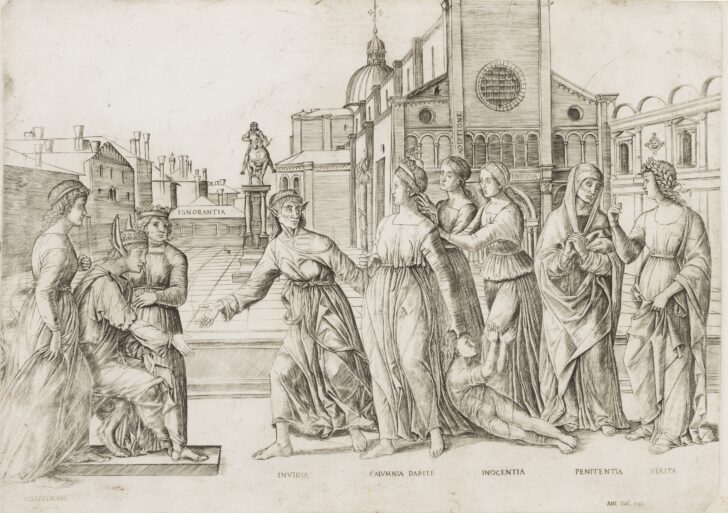The Calumny of Apelles
Girolamo Mocetto

Description
Mocetto combines a classical allegory copied from a drawing by Mantegna with a contemporary setting (though reversed)—the square in front of the Church of Saints Giovanni and Paolo in Venice. Mantegna’s drawing recreated the lost painting on the subject of the Calumny of Apelles, known to Renaissance readers only from a description by the Roman author Lucian.
Mantegna imagined his scene as a classical relief sculpture, with the figures arrayed in one plane in the foreground. Mocetto knit the scene to his architectural backdrop by means of a terrace bordered by a low wall, turning the relief into a drama. On the left we see a king sitting in judgment, his stupidity indicated by his ass’s ears. He is advised by Suspicion and Ignorance. Led by Envy and followed by Deception and Treachery, Calumny (slander) drags her victim, Innocence. To the right Penitence gazes sadly at Truth. In the Renaissance the allegory was interpreted as a warning against unjust rulers and travesties of justice. While Mantegna’s drawing was meant for an exclusive, learned circle, Mocetto’s engraved version was accessible to a wider, though still sophisticated, audience.
Gallery label text by Curator Annette Dixon, April 2002
In this print Mocetto has juxtaposed a classical allegory copied from a drawing by Mantegna with a realistic rendition (although reversed) of the campo (square) in front of the church of Saints Giovanni and Paolo in Venice. In his drawing, Mantagna had responded to the theorist Alberti's challange to painters to recreate the lost painting on this subject by Apelles, the most famous painter of antiquity. Apelles' painting was known only from a description by the Roman author Lucian, which Mantegna followed closely. On the left we see a king sitting in judgement, his stupidity indicated by his ass's ears. He is advised by Suspicion and Ignorance. Led by Envy and followed by Deception and Treachery, Calumny (slander) drags her victim, Innocence. To the right Penitence gazes sadly at Truth. In the Renaissance the allegory was interpreted as a warning against unjust rulers and travesties of justice.
While Mantegna's drawing was meant for an exclusive, learned circle, Mocetto's engraved version was accessible to a wider, though still sophisticated, audience. By placing the scene, enacted as a drama on a terrace before the campo, in a contemporary setting, Mocetto suggests the applicability of this ancient story to contemporary Venice. The printmaker may have chosen this setting for its association with rulers: the church was the resting place of Venetian doges (rulers) and is flanked by the celebrated equestrian momument of the condottiere, or mercenary leader, Bartolomeo Colleoni. It is possible that Mocetto intended a criticism of Venetian justice. The print was still popular well after Mocetto's death, when the Roman publisher Antonio Salamanca bought the plate and issued impressions, including ours.
Exhibition label text for "Venice, Traditions Transformed," September 21, 1996 - January 12, 1997 by Annette Dixon and Monika Schmitter.
Usage Rights:
If you are interested in using an image for a publication, please visit https://umma.umich.edu/request-image/ for more information and to fill out the online Image Rights and Reproductions Request Form.